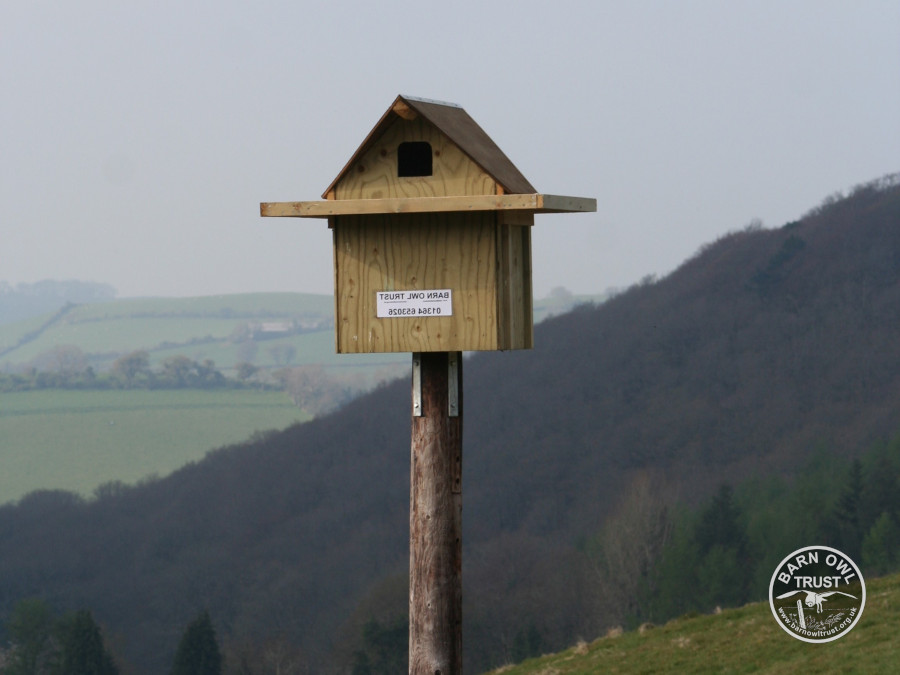Where’s the best place for your Barn Owl nestbox?
Where to put a nestbox for wild Barn Owls
Best option – Barn Owl nestbox inside a building
If there’s a large building that a Barn Owl can enter at 3+ metres above the ground then this is almost certainly the best place to put a new Barn Owl nestbox. An owl box in a building:
- Is easier to erect
- Costs less, or is quicker and cheaper to make
- Lasts much longer
- Affords extra shelter (that’ll be great for the owls)
If you have a building with no high-up entrance hole, can a small owl-hole be made? Mounting an owl box on the outside of a building has many disadvantages and is not recommended unless there is no alternative. Buildings that are in human or agricultural use can be very suitable; Barn Owls can get used to almost any kind of activity as long as they can stay out of sight.
Second best option – Barn Owl nestbox in a tree
Tree nestboxes are an option if no building is available, but the drawbacks are:
- More expensive to obtain or make than indoor boxes
- More difficult to erect than indoor boxes
- Don’t last as long due to partial exposure to the elements
- Don’t provide as much shelter
Also there’s a greater chance of occupation by some other species. However, provided that you have a suitable tree in a suitable position, they are a much more practical option than a polebox.
Third best option – Barn Owl nestbox on a pole
Pole nestboxes for Barn Owls are the least preferred option because they are:
- The most expensive by far
- The hardest to erect
- Not going to last long, compared with a nestbox in a building
- Completely exposed to the weather
The only major advantage of an outdoor polebox is that it can be provided almost anywhere. You are not dependent on there being a suitable building or tree on-site. The pole needs to be very substantial and generally has to be erected by machine with the box already on it – the costs are considerable.
Even better – Permanent Options
- How to build a wildlife tower
A wildlife tower is a very small building that provides nesting and hibernation opportunities for a huge range of wildlife – a building that’s not only beautiful and perfect for wildlife but will last for at least 100 years. - Making a Barn Owl nest space within a building project or in the loft.
If your area is suitable, it is perfectly possible to create an excellent, permanent nesting space for Barn Owls in a loft or roof space. Many types of rural building can have an owl roost or nest space built-in.
The presence of Barn Owls will not usually result in the refusal of a planning application for a barn conversion. We support the renovation and conversion of old buildings as long as permanent provision for Barn Owls is incorporated into the design. After all, an unused derelict building, however picturesque, will only deteriorate and eventually become unsuitable for Barn Owls to live in.
Hot Tips!
- Choose a well-designed owl box! The old adage “you get what you pay for” does not apply to Barn Owl nestboxes. There are some very badly designed owl boxes on the market! Watch the video on best nestbox design.
Order a Barn Owl Trust nestbox. - Don’t use a box at all! Why not create a home for owls in your loft? Barn conversions or farm houses are not the only types of building that can have an owl nesting space built-in.
How to create a nesting space for Barn Owls within a building project. - Barn Owls can’t eat boxes! Managing land for Barn Owls to boost their food supply is even more important than erecting nestboxes. Watch the video on land management.
- Find out what’s needed in a Barn Owl Home range? – does your location have what it takes? Once a Barn Owl has established a home range it will almost certainly remain there for the rest of its life – and the nest site they chose may be used for generations to come!
- Find out if your landscape is suitable. Barn Owls in the UK generally avoid dense forest and high mountains and are rarely found in urban and suburban areas.
- Two nestboxes are even better than one! There’s certainly a value in having two boxes available within a few hundred metres of each other.
– The closest simultaneous nests we’ve recorded were only 60 metres apart!
– Paired Barn Owls don’t generally roost together all year round and a second nestbox can provide an ideal alternative roost site
– During or after incubation, the male will normally roost away from the nest during the day and may well roost in the second nestbox.
– Similarly, at about 3-4 weeks of age the young are able to thermo-regulate, which means the female doesn’t have to physically brood them (keep them warm). At this time, the female will also roost away from the nest.
– In any one year, about 10% of pairs double brood. The second clutch of eggs is often laid in a nearby alternative nesting place.
– If anything should happen to an occupied nestbox, having another one already available nearby is a great insurance policy. - If you want to put a camera in the box it’s a good idea to plan this before you buy or build your owl home, otherwise the camera-view may not be great. Additionally, nesting birds and their dependent young must not be disturbed. Barn Owls and the law.
Find out more about Barn Owl nest boxes in the Barn Owl Conservation Handbook




